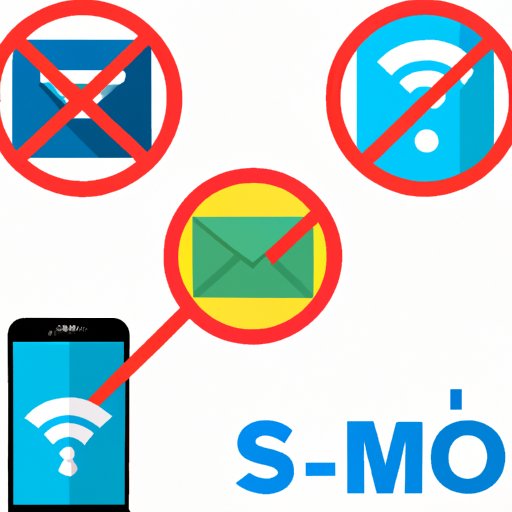I. Introduction
There are few things more frustrating than picking up your phone and seeing those dreaded words: “no service.” Whether you’re trying to make a call, send a text, or connect to the internet, this error message can leave you feeling disconnected and helpless.
But don’t worry – in this article, we’ll explore the common causes of “no service” issues and provide a step-by-step guide to troubleshooting and resolving the problem. From SIM card problems to software updates and hardware issues, we’ve got you covered.
II. Troubleshooting the “No Service” Issue
When you first encounter a “no service” error message, it’s important to try some simple troubleshooting steps before seeking more advanced solutions. Here are some basic steps you can take to try and resolve the issue:
- Check your phone’s network settings to ensure you’re connected to the right network.
- Try restarting your phone or toggling airplane mode on and off.
- Remove and reinsert your SIM card to ensure it’s seated correctly.
- Try using another SIM card to see if the issue is related to your carrier or account.
- Contact your carrier’s customer service department to inquire about network outages or other issues that may be affecting your service.
If none of these basic troubleshooting steps resolve the issue, you may need to pursue more advanced solutions, such as resetting your network settings or contacting a repair technician.
III. Possible Explanations for “No Service”
There are a few reasons why you may be experiencing “no service” issues on your phone. Some of the most common explanations include:
- Weak or poor reception in your area
- Damage to your phone’s antenna
- Outdated or incompatible software
- Problems with your SIM card or mobile account
Fortunately, there are steps you can take to address each of these issues and improve your phone’s performance.
If the problem is related to weak reception, you may be able to solve the issue by using Wi-Fi calling or purchasing an external antenna for your phone. If you suspect that your phone’s antenna has been damaged, you may need to contact a repair technician to have the issue resolved.
IV. Impact of Software Updates
It’s not uncommon for recent software updates to cause “no service” issues on phones. In some cases, these updates can create compatibility issues or even alter network settings, leading to connectivity problems for users. If you suspect that a software update may be the cause of your “no service” issue, consider these tips:
- Try rolling back to a previous software version to see if the issue goes away.
- Install any available software updates that may address the “no service” issue.
- Use online forums or customer service resources to identify compatibility issues with your phone or carrier.
V. Comparing “No Service” to Other Network Error Messages
While “no service” is one of the most common network error messages you may encounter on your phone, other messages such as “no signal” and “network error” can also be confusing and frustrating. Here are some key differences between these messages:
- “No service”: Indicates that your phone is unable to connect to any mobile network or carrier. This may be due to a problem with your SIM card, carrier account, or other issue.
- “No signal”: Indicates that your phone is unable to connect to any nearby cellular towers or other network devices. This may be due to weak signal strength or network problems in your area.
- “Network error”: Indicates that there is a problem with your phone’s configuration or network settings. This may be due to software issues, compatibility problems, or other factors.
To troubleshoot these issues, refer to the tips outlined in earlier sections of this article, such as checking your network settings, resetting network connections, or seeking technical assistance.
VI. Hardware Problems and Diagnosis
If your “no service” issue is related to hardware problems, such as damage to your SIM card slot or antenna, you may need to seek expert assistance to resolve the issue. Some tips for diagnosing and repairing hardware problems on your phone include:
- Inspect your SIM card slot for damage or misalignment.
- Check your antenna connection to ensure it’s seated properly.
- Consider purchasing an external antenna or upgrading your phone’s hardware if necessary.
- Consult with a repair technician to diagnose and resolve any hardware issues that may be causing the problem.
VII. Understanding Global Network Issues
Finally, it’s worth noting that “no service” issues can occur anywhere in the world, due to a variety of factors such as network outages, weak reception in remote areas, or limited coverage by your carrier. Some tips for staying connected while traveling or visiting remote areas include:
- Investing in a global phone plan or local prepaid SIM card to ensure connectivity.
- Using Wi-Fi calling or messaging apps when possible to avoid relying on cellular networks.
- Checking your carrier’s coverage maps or contacting their customer service department to inquire about coverage in your area.
- Carrying a backup phone or battery pack in case of emergencies.
VIII. Conclusion
Dealing with a “no service” error message on your phone can be stressful and frustrating, but it doesn’t have to be. By following the troubleshooting tips and advice outlined in this article, you can quickly identify and resolve many common issues, from SIM card problems to hardware issues and network outages. Always remember to consult with your carrier or a repair technician if you need further assistance, and stay connected no matter where you go.
